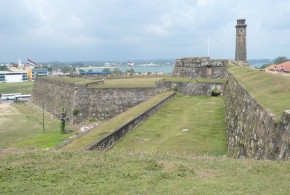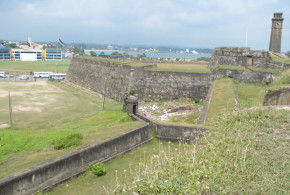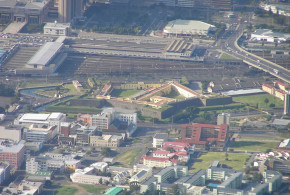Written by Marco Ramerini. English text revision by Dietrich Köster.
THE AFRIKAANS LANGUAGE
Afrikaans is a language of Dutch origin and structure similar to Flemish; it’s also influenced by various African languages and by Portuguese, German, French and Malay. Afrikaans was declared an official tongue of South Africa besides English in 1925.
Afrikaans is not only spoken by the White peoples of Dutch, Huguenot and German descent (about 60% of South Africa’s Whites), but also by the majority (about 90%) of the people of mixed descent (Coloureds). Today (2001 census) Afrikaans is the 3rd language of South Africa. 5,983,426 are Afrikaans first language speakers in South Africa, 146,000 in Namibia and 20,000 in Botswana. About 4,000,000 use Afrikaans as second or third language in South Africa.
According to the South African Census 2001, Afrikaans is the majority language in Western Cape province (2,500,748 speakers) and Northern Cape province (559,189 speakers) it’s the second language in Eastern Cape province (600,057 speakers), in Free State province (323,082 speakers), in Gauteng province (1,269,176 speakers), in North West province (275,681 speakers); there is a large number of speakers also in the other provinces: Kwa-zulu Natal (140,833 speakers, 4th), Limpopo (122,531 speakers, 4th) and Mpumalanga (192,129 speakers, 5th).
Afrikaans variants are: Cape Afrikaans (West Cape Afrikaans), Orange River Afrikaans and East Cape Afrikaans. Afrikaans Creole languages are: Oorlams and Flaai Taal.
The Afrikaaners/Afrikaners (Boers) have a rich mix of cultures in their blood: one estimate shows 40% Dutch, 40% German, 7.5% British (mainly Scots), 7.5% French and 5% others. These terms were first used in 1707.
According to the Namibian census 2001 the Afrikaans language is the second language of Namibia (11% of the total population). It’s the majority language in Karas region (40%) and in Hardap region (44%); it’s the second language in Erongo region (22%) and in Khomas Region (24%); it’s the third language in Omaheke Region (12%).
THE REFORMED CHURCH
The Reformed Church or Gereformeerde Kerk consists of three related churches, which according to a census represent more than 3,000,000 people. The Nederduitse Gereformeerde Kerk (NGK) is the largest of the three churches and has now more than 1,200 congregations and 1,300,000 members. The two smaller Reformed Churches are the Nederduitsche Hervormde Kerk and the Gereformeerde Kerk, which form part of the Afrikaans-language churches.
The other churches are the Uniting Reformed Church in Southern Africa, which is the result of the merging in April 1994 of:
– Nederduitse Gereformeerde Sendingkerk, (traditionally the church of the coloured people)
– Nederduitse Gereformeerde Kerk in Afrika, (traditionally black people)
– Indian Reformed Church in Africa, (with predominantly Indian members)
Today the Dutch Reformed Church has also six English-language congregations. There is also one congregation for Dutch-speaking people and four for Portuguese speakers. In total there are about 2,000 members in these congregations.
SOUTH AFRICA STATISTICS:
In the 2001 census South Africa had 44,819,778 inhabitants of whom 35,416,166 were Bantus (Zulu, Sotho, Xhosa, Tswana, Tsonga, Swazi, Ndebele and others), 4,293,640 were Whites (mostly Boers and British), 3,994,505 were Coloureds (people of mixed descent mainly Whites and Hottentots, the latter also called Namas or Khoi Khois) and 1,115,467 were Asians (mostly Indians, a few Chinese).
A more recent estimate (2005) of the South African population gives a total of 46,888,200 inhabitants of whom: African 37,205,700 (79,4%), White 4,379,800 (9,3%), Coloured 4,148,800 (8,8%) and Asian 1,153,900 (2,5%).
Mid-year 2007 estimate: Total 47,850,700: African 38,079,900 (79,6%), White 4,352,100 (9,1%), Coloured 4,245,000 (8,9%) and Asian 1,173,700 (2,5%).
Mid-year 2011 estimate: Total 50,586,757: African 40,206,275 (79,5%), White 4,565,825 (9,0%), Coloured 4,539,790 (9,0%) and Asian 1,274,867 (2,5%).
BIBLIOGRAPHY:
– Elphick, R., and Hermann Giliomee “The Shaping of South African Society, 1652-1820” ? 1979, Cape Town and London.
– Gerstner, J. Neil “The thousand generation covenant : Dutch Reformed covenant theology and group identity in colonial South Africa, 1652-1814” ? XI, 280 pp. E. J. Brill, 1991, Leiden, NL. A historical study of the role of theological concepts in the development of Afrikaner group identity during the period when South Africa was a Dutch colony.
– Guelke, Leonard “Freehold farmers and frontier settlers, 1675-1780” In: “An Expanding World” Vol. n° 4; Disney, A. “Historiorgraphy of Europeans in Africa and Asia 1450-1800” Ashgate Variorum, vol. n° 4, 1995; pp. 174-216 Also in: “The shaping of South African Society 1652-1840” 1986, Middelton, Connecticut, USA, pp. 66-108
– Guelke, Leonard “The anatomy of a colonial settler population: Cape Colony, 1657-1750” In: “An Expanding World” Vol. n° 29; Nizza da Silva, M. B. “Historiorgraphy of Europeans in Africa and Asia 1500-1800” Ashgate Variorum, vol. n° 29, 1998; pp. 293-313 Also in: “International Journal of African Historical Studies” Vol. 21, n° 3 1988, Boston, MA, USA, pp. 453-473
– Marais, Johannes Stephanus “The Cape Coloured People, 1652-1937” ? 296 p. Longmans 1939 London (reprint Witwatersrand University Press : 1957, 1968, 1978)
– Mc Carter, J. “The Dutch Reformed Church in South Africa. With Notices of the Other Denominations. An Historical Sketch” ? 152 pp. with 2 lithograph plates, W & C Inglis, 1869. A historical sketch of the development of the church under VOC and British rule its schisms and dissidents, as well as short data on other churches in the territory.
– Schutte, Gerrit “Between Amsterdam and Batavia: Cape society and the Calvinist church under the Dutch East India Company” ? In: “Kronos, Journal of Cape History” n° 25, 1998/1999
– Theal, G. “The history of South Africa under the administration of the Dutch East India Company (1652 – 1795)” 459+462 pp. maps, 2 voll. Swan Sonnenschein & Co., 1897, London, United Kingdom.
– Trotter, A. F. “Old Cape Colony: a Chronicle of Her Men and Houses from 1652 to 1806.” ??? 320 pp. illustrations throughout, County Library series No.II. Selwyn & Blount, 1903
– Worden, N. – Van Heyningen, E. – Bickford-Smith, V. “Cape town: the making of a city. An illustrated social history (under Dutch and British rule) ? 283 pp. with many illustrations. 1998, Hilversum. Beginning in the 17th century with the tiny Dutch settlement, the book charts the growth of Cape Town over almost three centuries, ending with the British colonial city.
 Colonial Voyage The website dedicated to the Colonial History
Colonial Voyage The website dedicated to the Colonial History

























